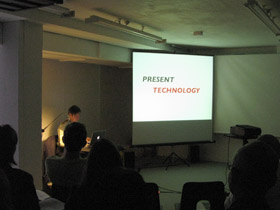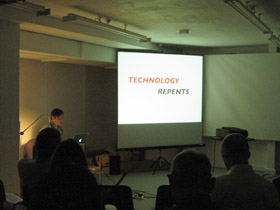PRESENT TECHNOLOGY
A two-day symposium organised by Emma Hart and Dan Hays. Hosted by the Contemporary Art Research Centre, Kingston University.
Day two: Screen as Landscape
Friday 16th July 2010, 10.30am - 5pm.
The discoveries of science and the intrusions of technology within our environment offer new paradigms, profoundly extending human perception and reach in spatial and temporal terms. Is the genre of landscape ideally placed to tackle debates around technology and human subjectivity – its relevance and poignancy heightened through our desire for control over, and consequent separation, from nature? Will humankind be consumed by the technological sublime, lost in a virtual wilderness: prismatic and poetic sensibilities integrated perfectly into code? Or is it vital or reassuring to engage with visual material and processes that reveal the flaws and limitations of technological representation, in a sense humanising it, giving the ubiquitous screen tangible form?
Invited artists and presentations: Beth Harland, Andy Harper, Dan Hays, Lizzie Hughes, Malcom Le Grice, and Guy Sherwin. Chris Horrocks will chair the panel discussion.


Good morning. I’d like to welcome all of you to Kingston University and hope you didn’t have too much difficulty finding your way here.
I’m Dan Hays – instigator of today’s event – Screen as Landscape, the second part of Present Technology, a symposium conceived and organised by Emma Hart and myself in connection with our practice-based PhDs in the Contemporary Art Research Centre.
We are both in the second year out of three, a time when a morass of information and possible lines of enquiry should be coalescing into some kind of manageable structure. The opportunity to invite a selection of artists whose work variously connects with what we are doing has been a wonderful, as well as a daunting, challenge. I must thank Sarah Jones, the fine art PhD co-ordinator for instigating and securing funding for this initiative.
Emma Hart came up with the umbrella title Present Technology for these two days, which wonderfully encompasses our different research interests.
Present Technology could be imagined as some kind of overview of current forms of equipment and mediation, falling within the bracket of the cutting edge, perhaps suggesting the awesome power of computers in terms of simulation, networking, analysis of data, etc. and the mesmeric seductions of high resolution flat-screens or data projectors.
TECHNOLOGY REPENTS
Yet this is where the title Present Technology is misleadingly playful. For rather than looking at state-of-the-art technology, we are both more interested the state of art within the prevailing tide of immersive entertainment presented, for example, by CGI, or the augmented reality and interactivity such as that presented on the iPhone via GPS and touch-screen technology. This is not to suggest that artistic responses to technology are in any way a new phenomenon. It’s just that technology is becoming ever more pervasive and increasingly transparent – progressively more integrated into our lives, yet also removed from any comprehension of its workings or any apprehension of its material existence.
Except when it goes wrong.
ELECTRONS GET PHONY
Foregrounding illusion generating technology presents a myriad of artistic possibilities, either accidental or elaborately nurtured. For example: mechanically describing the surface of the canvas, print or screen with visible brushstrokes, film grain or pixels; celebrating automatic stylistic idiosyncrasies, technical glitches, entropic scratches and deteriorations; examining generated bi-products such as repetitions, noise and blocking artefacts resulting from technological breakdown, data compression or corruption; reducing down to component parts and essential structures; or layering and synthesizing separate visual registers or streams of information. These processes follow technical and philosophical responses, both reactionary and celebratory, to burgeoning scientific theory and technology witnessed through Impressionism, Fauvism, Cubism, Abstraction, Futurism, Vorticism, Dada and Surrealism.
ONCE LENGTHY TROPES
Walter Benjamin’s celebrated 1935 essay The Work of Art in the Age of its Technological Reproducibility threw into question the aura of the unique art object with the proliferation of film and photographic reproduction. Yet Benjamin’s utopian vision of the accessibility of culture, accelerated by mass communication, hardly foresaw the passive consumer implicated by television and courted by advertising to be mirrored by Pop Art.
Structural filmmaking in the 1960s and 70s, of which Malcolm Le Grice and Guy Sherwin are leading exponents, began to examine and question the medium of film as a transparent vehicle for communication through revealing the metaphorical and literal nuts and bolts of this technology. These would include investigations of film’s illusion of linear time, through time-lapse and repetition; celebrating decaying fragments of early cinema and the entropic effects of successive copies; revealing the limitations of the camera in terms of photographic exposure and focus pulling; or challenging the unquestioned immersive nature of the film event through performance. The participation of Malcolm and Guy today is of genuine excitement, as seeing some of their work over the last few years has had a bigger influence on thinking through my own research than the majority of contemporary painters.
NO GHOSTLY PRETENCE
My work over many years has tried to engage with the technology of painting in the context of digital photography and image manipulation software, drawing distinct parallels and extreme contrasts. And, as I feel Guy’s and Malcolm’s work demonstrates, this is not without symbolic or poetic resonances related to the opacity and stubborn materiality of our chosen media and equipment. And this goes for the painting work of Beth Harland and Andy Harper, who in different ways approach the medium of painting as a still radical and potent vehicle for reflection on the influence of technology within their practices. In Beth’s case this is through distillation of the fragmentary and fluid nature of digitally mediated imagery, showing materialization into paint as analogous to memory retrieval. In Andy’s case, the self-duplicating fecundity of a systematic and expanding catalogue of gestural marks suggests a dark symbiosis of technology and nature, of genetic modification gone haywire, perhaps. Lizzie Hughes’s screen-based work highlights the absurd and sublime artistic possibilities offered through a direct engagement with information technology, making it tangibly present through processes of pictorial coincidence and subversion of its usual functionality.
These are just some of my personal thoughts about the artists presenting today, simply sketching a fuzzy outline of my reasons behind inviting them. I’m sure they will want to expand on these ideas and probably contest them.
LONG CHEESY PORTENT
Today’s title, Screen as Landscape, is intentionally elusive or ambiguous. It suggests the surface of the screen – be it paper, canvas or TV monitor – as equivalent to a section of landscape, offering the two dimensional cartography of the map, but also the suggestion of a topography – the physicality of paint forming a kind of terrain. But also, to my mind, it hints at the projected image presented by the camera obscura, an imaging technology with more associations to a kind of scientific objectivity or surveillance, where the screen both represents a transparent illusion of deep space, as well as being amenable to a two-dimensional mapping of visual information across its surface.
LECTERN GOES PYTHON
My feeling is that the work of the artists presenting today is carefully poised between the mediating, technological screen, be it filmic, painterly or digital, and a deeper, illusory space – in a sense inhabiting the screen as a physical landscape, confusing and reconciling oppositions of two and three dimensionality, or material presence and disembodied viewing.
I hope I haven’t been too prescriptive about the day’s theme, and expect to be taken into uncharted waters by the unfolding narrative of the day’s proceedings – both through the artist’s presentations and the involvement of the audience. To this end, there will be 5 to 10 minutes for questions and comments from the audience after each presentation.
GENTLY SCREEN PHOTO
I will now show some of my own work to give some more background to my research, hopefully shedding some more light on the thinking behind today’s event...

